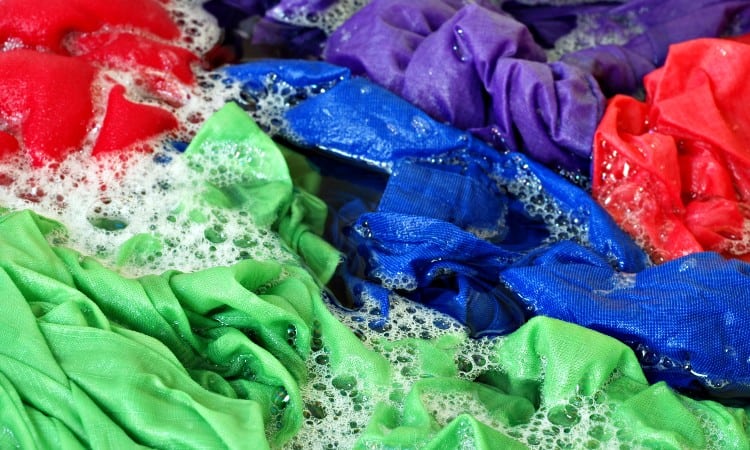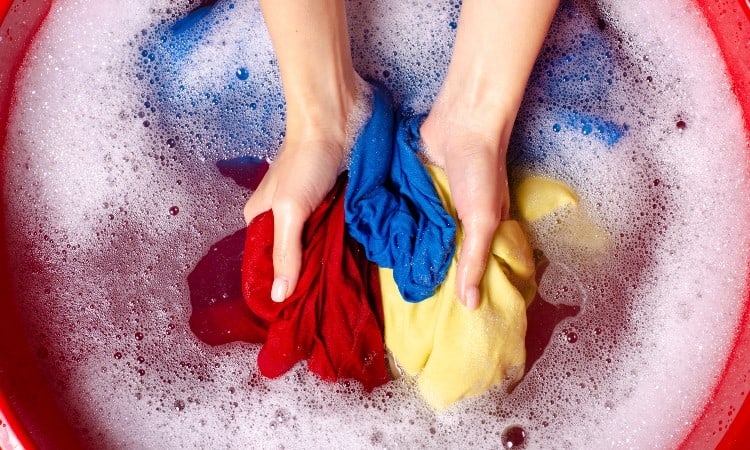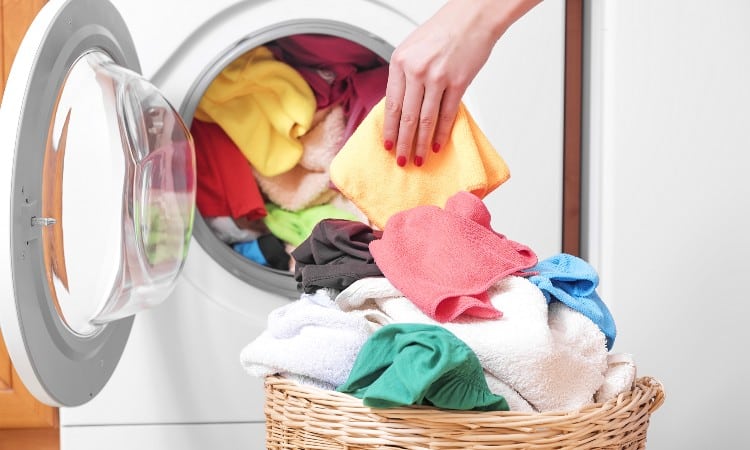Laundry baskets can hold a rainbow full of colors, can’t they? Unfortunately, washing some colors together can cause color bleeds. Do I have to wash every item on its own? Is there a way I can tell what shade can be washed with another? What colors can I wash together?
The key to washing colored clothing is to wash like with like. Sort colors into their color families. Dark, light, and white. Light and dark items need washing separately from each other. Wash white clothing with other white garments. Where possible, Further separate black and red clothing. Wash black with black and red with red.
In this article, I’ll take the confusion out of washing colored fabrics. You’ll learn what shades can be washed together and which ones you need to separate.

Quick Navigation
Why Is It Important to Sort Your Laundry?
Sorting your laundry is the best way to ensure the longevity of your clothing. It also helps keep colors vibrant and reduces the ever-present risk of your garment shrinking.
Washing different colors together can have a disastrous effect on your laundry. That red sock may be small enough to fit in a half-load of washing, but if it isn’t colorfast, you’ll turn your pastel blue shirt a blotchy purple.
Those accidental color transfers don’t just cause color runs. They can also speed up the process of white garments going gray. Even if you are washing an item you’ve laundered a thousand times before, there may be a hint of dye left to suck away the brilliant whiteness of your white shirt. Dragging it down to dull and drab.
Not only will sorting your laundry help protect the color of your clothing, but it also helps you wash items at the right temperature. Check the care label on each item before you pop them in the machine together. It’s too easy to wash a blue garment with other blues, only to find it shrunk because the water was too hot.
Then there are the different types of material. How often have you pulled a dark t-shirt from the washing machine to find it covered in tiny lint particles? This happens when fabrics that shed lint in the wash are mixed with those that don’t.
Bath and hand towels are the main culprits for shedding lint. You should never wash them with your shirts, sweaters, pants, or dresses, particularly if your clothes are black, brown or dark blue.
Before you start washing your clothing, you should always sort it first. You may end up with smaller piles of washing and lots of different loads. But, this can be a good thing.
With less clothing in your washing machine, you’re unlikely to overfill it. Overfilling a washing machine stops it from working properly and leads to color fading. This is down to detergent residue caught in the fabric fibers instead of being rinsed away.
Sorting your laundry really is a win-win, not just for color vibrancy but also for a successful wash resulting in spotlessly clean clothing.
What Colors Can I Wash Together?

The quick answer is you can wash garments of any color together as long as they are colorfast or old. However, it’s not always that simple. Even a colorfast garment can bleed color if it’s washed incorrectly. Old clothing can still contain traces of dye that can lead to a color run. It depends on the garment and the pigments in the dye.
Doing the laundry can feel like a minefield of potential disasters. They are avoidable, though. All you have to do is follow a couple of laundry rules and your wash day should be plain sailing.
These rules have been in place for generations. They are tried and tested and will help you identify what colors you can safely wash together.
1. Check Your Care Label
Always check the care label. These are put inside every new garment. They tell you how to wash it, what it’s made from, and if it can be washed with anything else.
The care label will show you if it’s machine washable or dry clean only. You’ll know if it’s heat intolerant or dryer-proof.
Ignoring the care label can lead to severe laundry day blues. Many wash-day nightmares begin with not reading the label. For instance, washing something designed to be “dry clean only”, can lead to color bleeds or worse. Destruction of the entire garment.
In these days of ecological concerns and a deep-rooted longing to save the planet, it can be tempting to throw everything in the wash together. Just set the temperature to cold, grab a color catcher, and chuck it all in, regardless of what the care label says.
Unfortunately, not all garments can withstand the same laundry conditions. If your colored garment isn’t washable, even a cold temperature can cause it to lose vibrancy and become dull and drab. Particularly if the color happens to be white.
The thing is, clothing manufacturers, go to great lengths to test their garments. Their recommendations are designed to protect your garment and ensure its longevity. So always read the label and only sort the washable clothing from the dry clean.
When you’ve done that, check the washable pile again. This time, check the temperature you can wash each item and the length of time the garment can be in a wash cycle. These things may seem insignificant, but they will make the difference between a successful wash and a catastrophic color bleed.
2. Separate Your Fabric Types
Fabric comes in many styles and types. From delicate materials like your silk shirt to the fluffy softness of your bath towels. Now you’ve sorted your washable colored clothing into a hot wash and cold wash; your next step is to separate the lightweight from the heavy.
You can’t wash silk with bath towels. The towels are too heavy and will only get heavier when they are full of water. That excess weight can damage the fragile silk. So even if the silk is the same shade of red as your fluffy towel, make sure you put them in separate piles.
The same goes for all your delicate items. Regardless of the color, you should never wash any delicate garment with rough or heavy fabrics. Things like jeans with zippers and rivets need to stay well away from your lace underwear.
Another thing to be careful of is lint. Fluffy bath towels, hand towels, and even some tea towels can all deposit lint into the wash water. This isn’t necessarily a problem if the clothing you wash them with is white, but add color into the mix and you’ll have a bit of an issue.
Colors, particularly darker colors, will pick up the lint from the water. They’ll come out of the wash looking like it’s been snowing. Never wash your bath towels or other fluff-covered items with dark-colored clothing. Or you’ll be picking the lint off from now till next Christmas.
3. Sort Your Darks From Your Lights
There are three color families you need to be aware of. Dark, light, and white. All three should be kept separate from each other. As dark-colored clothing tends to be the most likely to bleed, you should never wash them with light colors or whites.
Dark shades include black, brown, and navy blue. They can also include deep red and dark shades of green. Light shades are pastels like yellow, pink, and lighter blues and greens. As you can see, each color family has different shades of color pigment.
Although dark colors are all classed as dark, you don’t want to wash them all together. The same goes for the pastel shades. Dark red and navy blue have the power to turn purple, especially if they aren’t colorfast. A pale yellow and a vibrant pink is going to turn orange.
Ideally, you should be washing like with like. This means separating all the colors into their individual shade. Yellow with yellow, blue with blue, and so on. If it isn’t possible to do that, you can wash pastel shades with pastel shades or dark with dark, but make sure you use a color-catching product.
There are three shades of color you should always wash separately from any other hue. The first is black. Black clothing washes better with other black garments due to the nature of the dye. Secondly, there is red. Red is the one shade notorious for causing color bleeds.
Lastly, white clothing is more likely to pick up dye floating in the water, even from pastel garments. Because of this, you should only wash whites with whites.
What Do You Wash Colors On?

What you wash your colored garments on depends on a couple of things. The fabric content and the type of garment it is.
This is one of those times you need to pay attention to the care label inside your garment. Particularly if your colored clothing is new. Not only will the label tell you what your clothing is made of, but it will also give you a recommended water temperature for that item. These tidbits of information will help ensure you wash your colored items in the right settings.
New blue jeans, for instance, should be washed using a cool setting on their own. Blue jeans are well known for losing color, especially in the first wash. Keeping the water temperature down should help minimize the amount of color bleeding out.
Your care label will also let you know if your garment is washable or not. If it says dry clean only, take the clothing to a professional dry cleaner. Sometimes you might see a diagram of a hand in a bucket. This means the item is hand wash only.
Hand washing a garment is softer and less rigorous than machine washing. This symbol indicates a delicate item that needs care. It also suggests a cooler water temperature than a machine can manage.
If you don’t have a care label, consider hand washing the garment by itself. There are two benefits to this choice of action. First, the water will be hand-hot and less likely to damage the fabric of your colored garment. Secondly, you’ll see if there is any color bleed in the water as you wash it.
How to Wash Colors

Washing colors is a lot easier than you think. All you have to do is follow the rules of the laundry room and you’ll be washing your colored clothes like a pro.
The way you wash colored clothing is generally the same as for white garments. There is one subtle difference, though. Some colors need a little more care than others. In the following step-by-step guide, I’ll walk you through how to wash colors successfully.
You will need:
- Colored Garments
- Laundry baskets
- Washing machine
- A detergent suitable for colored clothes
Step 1
Separate your colored garments into piles. Use different laundry baskets, so you have one for dark colors, light colors, and white clothing. We’re going to start with dark clothing.
Step 2
Separate the black, brown, and navy blue colors from the dark clothing basket. Put the brown and blue garments back in the basket for now. Grab your pile of black clothes and check the care label. You want to make sure you can wash all the black items at the same temperature. Remove any that say dry clean only. You do not want to wash those.
Step 3
Set your washing machine to the temperature acceptable for all the black garments. If most garments can be washed using a warm setting, but one says cold, only wash the warm temperature garments together. Put the cold garment to one side to be washed in a different load.
Step 4
Wash the black clothing with a detergent suitable for colored items. When the cycle has finished, dry the garments according to the instructions on the care label. It’s best to avoid the dryer with black clothes as the heat can cause fading.
Step 5
Follow the above steps for your pile of brown and blue clothing. Then move on to the light-colored clothes, then the whites. In each case, make sure you don’t wash items marked “cold wash”, with items that can be washed at a warmer temperature.
Step 6
Check the items you have put to one side for washing in another load. If the brown and blue items are all colorfast, you can wash them together. For light-colored garments, keep to the same color family. So wash yellow with orange, beige with light brown, pink with fuchsia.
Keep black, red, and white out of the picture. These three colors should only be washed with other black, red, or white garments. Never mix them.
How to Wash a Multicolored T-Shirt
Sometimes garments can be more than one color or have decorative elements in numerous shades. This can add a little bit of confusion to your laundry, particularly if the accent color is minuscule.
Any t-shirt with stripes, color blocking, or a patchwork of different hues comes under the category of multicolored. The problem is that not only can they be different shades, but they can also be from different groups. You can get dark, light, and white in the same garment.
Multicolored clothing tends to be colorfast. So, in theory, you should be able to wash it as you would any colored item. Unfortunately, being colorfast isn’t always the case. When your t-shirt has more than one shade, you need to take extra care in the laundry room.
It can be tricky to tell which color family a multicolored garment belongs to. The key is to look at the amount of your t-shirt that is one color. If you have more white than color, put the shirt in the white pile.
For garments with more color than white, check the shade of the color. Pastels and white should go with lights. Dark colors and white should be put with dark clothes.
As with any colored garment, check the label inside your t-shirt to find out what temperature you should wash it at. Many color bleed accidents in a multicolored garment happen because an item was washed on the wrong heat setting.
For an added boost of safety, add a color catcher to the wash cycle. Then, if any color in your multicolored t-shirt does run, the color will go on the catcher, not the rest of your shirt.
Can I Wash Dark Clothing With Dark Bath Towels?
Although it sounds tempting to wash dark clothes with dark bath towels, it’s not recommended. The reason is the difference in fabric type. It’s not just different colors you have to watch out for. You need to allow for the transfer of lint.
Bath towels are fluffy. This fluff comes off in the wash regardless of the color of the towel. It isn’t just bath towels either. Lint is shed by hand towels, tea towels, blankets, and some fluffy sweaters.
The lint floats about in the water until it comes into contact with a garment it can stick to. Usually, your shirt, your pants, or another sweater. Dark-colored garments are like magnets for the soggy lint fibers. Wash any dark garment with a bath towel and it will look like it was caught in a blizzard.
You can remove the sticky fluff with a lint roller or brush. But it’s going to take you time and is incredibly annoying. For your sanity, keep dark-colored items away from any kind of towel or fluffy item. Only wash towels with towels.
Should Jeans Be Washed Separately?
You can wash your jeans separately. In most instances, it is advisable to do so. However, you don’t always need to.
New jeans that haven’t been washed will bleed color. Regardless of whether they are black, distressed, or blue jeans. These should be washed separately from anything else, even from other items made from denim.
Jeans can be washed with other denim items that are of a similar shade. So your blue denim jacket will be fine if you wash it with your matching denim blue pants. You can also wash older jeans with other denim items.
Old jeans will have faded as much as they are going to, so these can be washed with other jeans, denim shirts, skirts, and even heavy work pants. As long as all the other items are colorfast or have also been washed many times before.
What Should You Not Wash Together
When it comes to the laundry, there are several items that you shouldn’t wash together. It’s not only due to the color of the garment. You also need to watch out for fabric type and weight.
Washing your delicate clothes with denim jeans will never end well. Jeans are heavy and rough and can tear at the fabric of a more fragile garment. They also have multiple rivets and a heavy-duty zipper that can catch and snag material that is both lighter and less robust.
As we’ve already seen in this article, you shouldn’t wash dark colors with whites or light colors with dark. The dyes used in darker garments can bleed out during the wash cycle. Lighter clothes, especially white, can soak up the floating pigments and become stained.
Fluffy fabrics should also be kept to themselves. Lint and fluff can create issues in the laundry room. They are attracted to dark-colored garments and stick to them like glue. Because of this, bath towels, hand towels, and tea towels should only be washed with other towels.
Sticking with towels for a moment, you should never be tempted to wash your socks and underwear with your towels. Washing your undergarments with towels, particularly tea towels, can cause health issues.
Conclusion
Washing colored clothing is a lot easier than you might think. All you need to do is follow a few simple rules for laundry success. Keep dark, light, and white clothing separate from each other. Always wash your garments at the recommended temperature.
Has this article helped you wash your colored garments? Have you ever had a color bleed accident? Let me know in the comments.